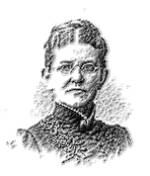The first thing most people think when asked about the Victorian era, is etiquette. While we had conventions and practices of proper eating prior to Victoria’s reign, these were taken to new heights and levels of complexity during the era. Knowledge of these social expectations was vital to respectability and could make or break even a housemaids chance at success. But unlike my childhood, there were no formal cotillion classes full of bored pre-teens stumbling through the fox-trot, no frustrated teacher drilling those rules of behavior into young minds.
So how did the lower classes & the growing immigrant population of bustling cities like Boston learn the social fundamentals of the late Victorian era? Books and magazines were an obvious choice, but for the hands on learner, cooking schools helped fill the void of practical etiquette training.
In the later chapters of “What to Do & Not to Do in Cooking”, Mary Lincoln gives advice to others on setting up their own cooking classes. One of these suggestions is to arrange the foods prepared during class into a luncheon afterward, giving the teacher an opportunity “to instruct in laying the table and sering the food” (484) as well as teach cooking. She clearly saw the potential for cooking schools to reach beyond the singular skill of cooking and to address the social & cultural expectations surrounding meals as well.
“What to do & not to do” includes a short, but comprehensive section on laying the table, food service, advice on table manners and even tips for those hosting a dinner or luncheon party. However, her best advice is the simplest. Rather than “following mere arbitrary rules” (442), which she says can be both practical and useless, when dining with others the best etiquette is to simply “follow the level of strictness observed…” (442) by those we are eating with.
Mary wasn’t the only one who saw the potential for using the cooking school to teach more than mere recipes. We can assume that Fanny Farmer continued Mary’s teaching methods when she became principal of the Boston Cooking School, since the 1896 edition of “The Boston Cooking School Cookbook” under her name includes a nearly identical section of advice on after-class luncheons. Juilette Corson also suggests the same practice at her New York cooking school. Many other cookbooks of the era also include sections on basic etiquette and manners, even though this isn’t their primary focus.
In an era before Miss Manners, when etiquette rules were a hard & fast dividing line between respectability & vulgarity, it’s understandable why these topics would have been included along with advertised cooking lessons at schools like the Boston Cooking school. Table etiquette & manners are a natural progression from the basic lessons and provided additional context for the subject at hand while also offering a unique opportunity for practical application of these skills.
Not to mention, someone had to eat all that freshly made food!
Works Cited
Bad Manners at the table, Hill’s Manual of Social and Business Forms, 1886
Corson, Juliet. Cooking School Text Book; and Housekeepers’ Guide to Cookery and Kitchen Management. An Explanation of the Principles of Domestic Economy Taught in the New York School of Cookery. New York, NY: Orange Judd Company, 1883.
Lincoln, Mary J. Mrs. Lincoln’s Boston Cook Book: What to Do and What Not to Do in Cooking. Boston, MA: Roberts Brothers, 1884.



